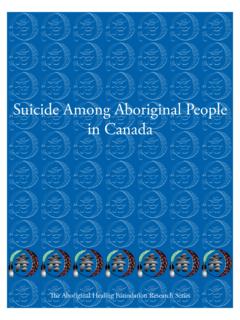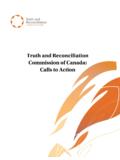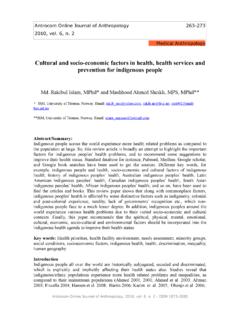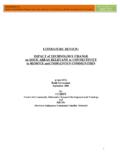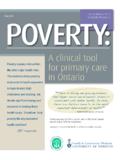Transcription of Rural Crime Prevention
1 Rural Crime Prevention : A Literature Review September 6, 2011 By: Jennifer Fraser, PhD Candidate Department of Criminology, University of Ottawa 1 Contents Introduction .. 2 What is Rural Crime ? .. 2 Who is affected by Rural Crime ? .. 4 Can Rural Crime be prevented? .. 5 What is being done to prevent Rural Crime ? .. 7 Community Watch .. 7 Crime Prevention Through Environmental Design .. 8 Crime Prevention through Social Development .. 8 Policing .. 10 Situational 11 Conclusion .. 12 References .. 13 2 Introduction Crime Prevention Ottawa (CPO) is interested in exploring the issue of Crime Prevention in the Rural areas of the Ottawa region.
2 As a first step to addressing Rural Crime through Crime Prevention , CPO chose to embark on a literature review of Rural Crime Prevention . A literature review is a search of academic research studies that have looked at the issue of Crime Prevention in Rural contexts. This literature covers both theoretical and experimental studies that have been conducted on Rural Crime Prevention in Canada, the United States, Australia, and the United Kingdom. It also looks at what different communities are doing to prevent Rural Crime at the local level. Understanding what is already known about Rural Crime and how to prevent it is an important first step to addressing the situation in the Ottawa area.
3 Using this literature, Crime Prevention practitioners can identify the important steps to developing an effective Rural Crime Prevention initiative: learning about the characteristics of the specific community and its Crime problem; developing and implementing a program; and, evaluating the results. As well, this literature shows some examples of what has worked in other communities to prevent Rural Crime . What is Rural Crime ? Rural Crime is any violent, property, or other type of Crime that occurs in the country . This may be in agricultural areas of land, in small villages or towns, or any other areas that are outside both small and big cities.
4 The rates of violent and property Crime recorded by the police are lower in Rural areas than they are in both small and big cities. For violent offences, offenders in Rural areas are less likely to use a weapon than those who commit crimes in cities. However, homicides committed with firearms in Rural areas are more likely to involve the use of a rifle or shotgun, whereas, in cities, the firearm of choice is a handgun. Victims of violent Crime in Rural areas are more likely to know the perpetrators of crimes, likely due to small populations and tight-knit communities found in Rural areas.
5 Victimization surveys in Canada have found that residents in Rural areas are slightly more satisfied about their safety from Crime than residents in large cities. Similar results were found for Rural residents satisfaction with the police in their area (Francisco & Ch nier, 2007). Rural Crime is different than Crime that occurs in cities. In many Rural areas, residents live far distances away from their neighbours. Residents may also drive into the city to go to work or go shopping during the day, and children and youth often have to travel long distances to go to school.
6 This means that houses and other property are left unattended during the daytime and into the evening hours. There is also little police presence in many Rural areas because of the large areas these officers have to patrol. All of these factors mean that crimes can be committed in Rural areas fairly easily without anyone seeing (Sagarin, Donnermeyer, & Carter, 1982). 3 Early research into Rural Crime focused on vandalism and petty theft committed by amateur criminals ( , Polk, 1969). Later, researchers identified the operation of more professional criminals in Rural areas, including in farm equipment theft, livestock theft, and burglary (Sagarin, et al.)
7 , 1982). Whereas in the past, these professional criminal acts may have been difficult to pull off, modern highways and vehicles make committing these crimes much easier (Barclay & Donnermeyer, 2007b). Now it is recognized that many of the same types of crimes that occur in cities also occur in Rural areas, even if there has still not been much research in the field. The following is a list of some of the types of crimes that occur in Rural areas and how they differ from the same crimes committed in cities: Domestic violence occurs in Rural homes like it does in homes in the city.
8 However, victims tend to be much further away from help than they would be in the city and may lack transportation to get to shelters or counselling services in the city. Because of tight-knit Rural communities, victims may be embarrassed to speak out about the abuse or fear retaliation from the abuser s friends or family (Wendt, 2009). Guns are also a major factor in domestic violence in Rural areas. In a study conducted in New Brunswick and Prince Edward Island, 66% of abused women who lived in households containing guns said that the guns made them more fearful for their safety and well-being.
9 In this same group of women, 70% said that the guns had an effect on their decision to tell others about the abuse (Hornosty & Doherty, 2007). Drug and alcohol abuse were traditionally thought to be big city problems. However, alcohol abuse and illicit drug use are often found in Rural areas at similar rates as found in urban centres (Webster, Pimentel, Harp, Clark, & Staton-Tindall, 2009). An Australian study found that people living in Rural areas were slightly more likely to use alcohol and tobacco and slightly less likely to use illicit drugs than people living in big cities (Australian National Council on Drugs, 2002).
10 Problems with drugs and alcohol can arise in Rural areas as they may be the only source of entertainment and may be related to boredom, especially among youth. Among adults living in Rural areas, drug and alcohol abuse can be related to stress over unemployment or insufficient income, isolation, and working long hours (Bull, 2007a). Drug and alcohol abuse treatment programs are also less accessible, available, and affordable for people living in Rural areas, making it difficult for residents to get clean (Booth, Kirchner, Fortney, Ross, & Rost, 2000).
